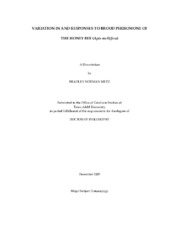| dc.description.abstract | Brood pheromone of the honey bee, (Apis mellifera) has been shown to elicit a wide array of primer and releaser effects on non‐foragers and foragers leading to the
regulation of nursing, pollen foraging, and behavioral development such that the
behavior of the colony may be regulated by the amount and condition of the larvae. To
date, all studies into the effects of brood pheromone have either used uncharacterized
whole extracts or a single blend of brood pheromone characterized from a population of honey bees in France. The variation in the relative proportions of the ten fatty‐acid ester components that characterize brood pheromone and some effects of this variation
on pollen foraging and sucrose response thresholds were therefore observed. The objectives met in this dissertation were to determine whether changes in brood pheromone component proportions (blend) or amount communicates larval nutritional status and reports the results of observations of nurses and foragers in response to blends of brood pheromone from deprived and‐non deprived larvae, to measure how changes in brood pheromone blend changed pollen foraging behavior and if such changes could account for the pollen foraging differences between Africanized and
European bees, and finally to observe the effects of exposure time on brood pheromone blend and to observe whether non‐foragers made contact with the pheromone. Brood pheromone was found to vary by larval rearing environment, but did not elicit the expected behaviors that would support a cue of nutritional status. Brood pheromone also varied significantly by mitochondrial lineage/population source and responses to brood pheromone appeared to be coadapted to blend, suggesting that brood
pheromone may be important in race recognition. Finally, brood pheromone varied significantly over time and was found to be removed from sources by bees, suggesting
possible mechanisms for loss of effect. Combined the results of this research indicate that brood pheromone blend differences lead to profound changes in colony behavior
related to pollen foraging and food provisioning, providing novel tools for colony manipulation and mechanisms for understanding brood rearing division of labor and
chemical communication. | en |


